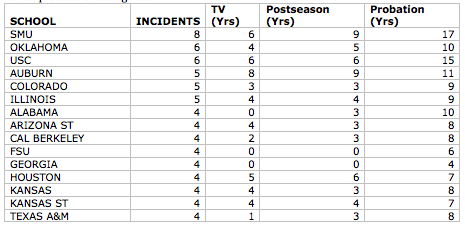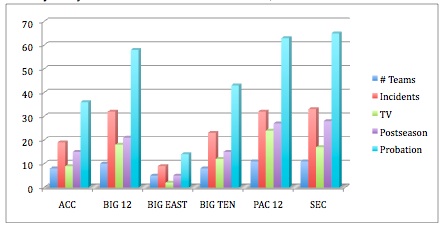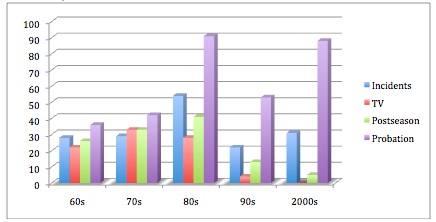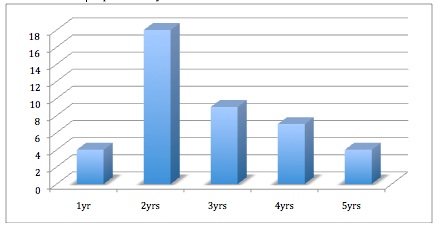As we approach the end of October and UNX’s date with NCAA destiny, I wanted to do a little research on actual documented NCAA penalties to see if I could properly set my expectations. Â There’s a lot of misinformation out there, things like “UNX had 9 major violations in the NOA – that’s the most ever”, and I wanted to find the real facts.
Background
For the record, this study is compiled from publicly available data provided by the NCAA here. Â Note: from my experience, getting data from this database can be frustrating. Â As my dad says, “Son, sometimes you just have to hold your mouth right.” Â You’ve been warned.
Also, there is no way I could find to extract the data in mass, so it was collected by painstakingly querying year by year and recording the results in Excel while saving off the file artifacts. Â It is very possible that I made a typo or two along the way. Â Caveat emptor.
I have limited the scope of this analysis according to the following constraints:
- Only include schools currently designated as Division I FBS
- Only include penalties that involved the football program (Note: there is no way to filter out “football AND other sports” as opposed to pure football cases). Â If such is warranted, I may make this distinction in the subsequent analysis
- Only include penalties associated with “major” violations, as defined by the NCAA at the time of the penalty. Â In other words, ignore secondary violations.
- Only include data from the years that the NCAA provides data, i.e. 1953-2011
Although the data set spans all years from 1953-2011, there are some facets of the analysis that will look at subsets of this data.
The NCAA provides the following information for each case:
- The “public file” – a PDF file released by the infractions committee discussing in detail the findings and the penalties
- A “summary” web page with information distilled from the public report
Note that each “case” represents an investigational unit of work. Â Each case can therefore detail multiple instances of violations. Â I don’t recall the offender, but in reviewing a couple of the individual case public files, I saw one instance with twenty to thirty major violations listed – giving the lie to the “9 major violations, most ever” drivel. Â The likely driver of this comment is the fact that SMU had 8 major cases (each with multiple major violations), along with some understandable wishful thinking.
Part one of my analysis will focus on the “summary” pages:
- TV ban (# years)
- Post season ban (# years)
- Probation (# years)
- Additional imposed penalties: financial aid (scholarships), recruiting limitations, “show cause”, and vacation of wins. Â In the summary data, each of these is a simple Yes or No.
In later analysis, I will try to extract information from the detailed “public files” to provide validation of the NCAA’s summary pages and to examine findings and penalties at a more granular level. Â If it is possible to extract anything meaningful from this data, I will publish it at a later time.
Analysis
Right off the bat, let’s see what we can learn from the raw data. Â Some interesting points jump out:
- Last time a TV ban was imposed: 1994, Ole Miss, 1 year
- Last time a post-season ban was imposed (everybody reading this can probably answer this): 2010, USC, 2 years. Â But significantly, the time before that was Mississippi State, 2004
- First reduction in financial aid: 1974, Illinois
- First reduction in recruiting: 1969, Texas A&M
- First show cause action: 1987, SMU
- First vacation of record: 1995, Alabama
“Superlatives” and Aggregates
Over the time period, a total of 195 major penalty cases have been issued to 81 unique schools. Of these, 52 schools (64%) were penalized multiple times. The worst 15 offenders (18.5% of total) account for 71 of the cases (36.4%). These “Champions of Cheating†are:
The overall “Champion†would depend on your definition. In sheer number of cases, SMU reigns supreme, and the impressive total of 32 years combined TV, postseason and probation is also highest. I tend to consider the TV bans and postseason bans to be the worst of the penalties: by this measure, the Champion is Auburn.
Conference analysis is difficult, at best. Whole conferences have come and gone in the intervening years, and conference membership has been fluid as well. But just for grins, let’s look at the current BCS conference definitions and see if we can see any patterns.
Since my old eyes cross when I look at tables of numbers, let’s visualize:
Much better. Some observations:
- The common argument that the SEC cheats far more than anybody else is not supported.
- Although the Big Ten and ACC like to brag about their clean programs (especially compared to SEC), there’s plenty of mischief going on.
- The NCAA is overly fond of “probation†as their primary penalty.
- Bear in mind that all of the TV bans were pre-1994.
- Although this data doesn’t include the two likely worst historical cases of ACC cheating (UNX 2010 and Miami 2011), it appears the ACC cheats a lot compared to the degree of national “prominence†that has been attained (i.e. we can’t even cheat well…)
Comparisons across all time frames show clearly that the penalty mix has evolved over time. We can see this by comparing aggregated data by decade:
And visually, this looks like:
In the 60s and 70s, a major penalty almost guaranteed a TV and postseason ban. In the 80s and 90s, as television becomes a much larger part of the overall revenue stream, these penalties are increasingly de-emphasized. By the 2000s, they are almost non-existent. Also of note is the drop off in the 90’s of the number of incidents that were actually pursued.
So if there are no TV bans and precious few postseason bans, what exactly has the NCAA been handing out? To analyze this, let’s consider only the penalties that have been handed down during the “BCS-eraâ€, i.e., since 1998. During this time, the NCAA has handed down penalties for 42 “major†cases. In aggregate, these have resulted in:
- 0 years total TV bans
- 8 years total postseason bans – 6 cases (14%), min 1yr, max 2yr
- 115 years of probation – 42 cases (100%), min 1 yr, max 5 yr
- 26 cases (62%) with “financial aid†penalties
- 19 cases (45%) with “recruiting†penalties
- 19 cases (45%) with “show cause†penalties
- 13 cases (31%) with “vacation of wins†penalties. Note that these penalties skew heavily toward the latter years.
The distribution of probation years looks like:
Conclusions
So what does this tell us about what may be in store for UNX?
- There will be NO TV ban
- There MAY be a post-season ban, but it is still very unlikely. It all hinges on whether the NCAA considers this case to be one of the most serious of the decade. Remember, it’s the NCAA’s opinion that matters here, not mine, not yours. And I think they gave us a very big clue when they did not cite for “lack of institutional control.â€
- Bear in mind that in spite of the myriad “prongs†associated with the ongoing scandal at UNX, the NCAA will penalize only based on what they uncovered and/or what the school self reported. They can open subsequent investigations, but that will be a separate process.
Resulting Prediction
Based on this (admittedly high-level) analysis, here’s my prediction for what we’ll see just before Halloween:
- No TV ban
- No postseason ban
- 2 years probation
- Possible show cause for former assistant coach John Blake
- Likely “financial aid†penalty, resulting in loss of scholarships. Insufficient data to estimate how many / how long.
- Possible, but less likely, reduction in recruiting
- Mixed bag on vacation of wins: call it a tossup
This should set the bar for the approximate magnitude of the resulting penalties. Of course, as Mies van der Rohe famously said, “God is in the detailsâ€. Of all these potential penalties, only the financial aid and recruiting hold any possibility to actually punish the program. Any show cause will likely be limited to John Blake, who is already gone. Vacation of wins means squat to a program that hasn’t won anything to speak of. Probation only means that things will be worse for them IF they are caught again during the duration1.  The degree to which they are punished will ultimately depend on the number and duration of scholarship reductions, and the possibility of recruiting limitations.
Unless there are major flaws in this work (which I’m sure will be swiftly pointed out in the comments below), it all adds up to an anticlimactic slap on the wrist. Maybe this is why the recruits keep coming. Who says cheating doesn’t pay?
1Even this is questionable, since the preponderance of evidence suggests that the NCAA is loath to issue the TV and postseason bans. In subsequent analysis, I will try to determine if any of the BCS era repeat offenders were on probation during the second offense. The degree to which the NCAA increases the penalty (or not) should be enlightening.









You must be logged in to post a comment.